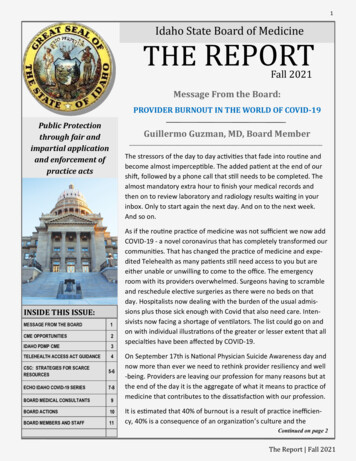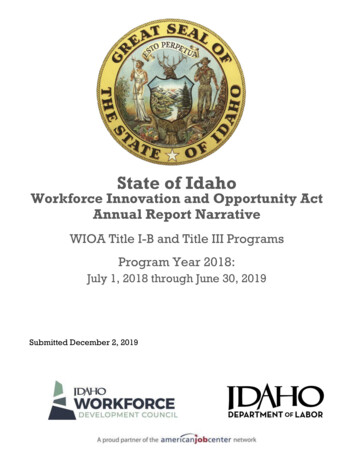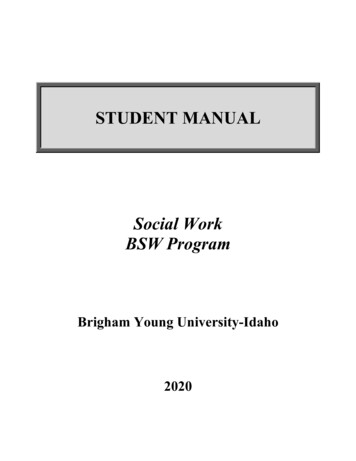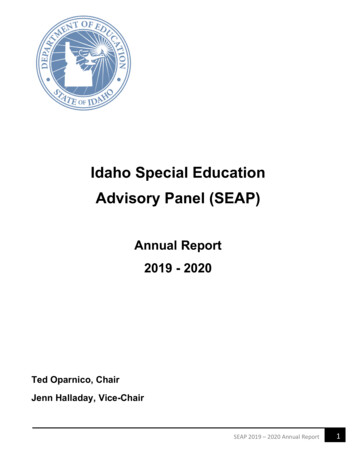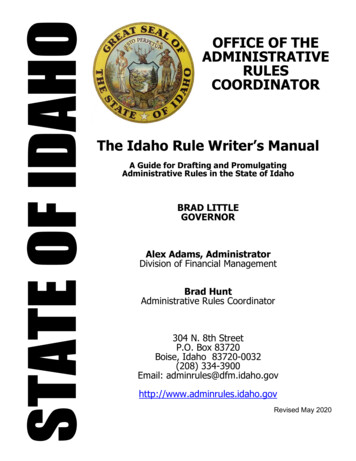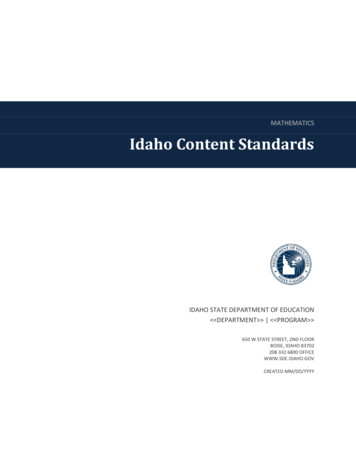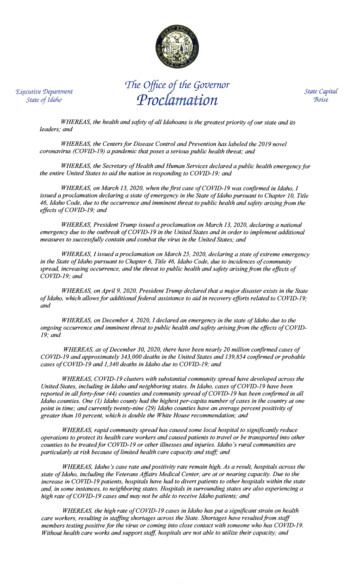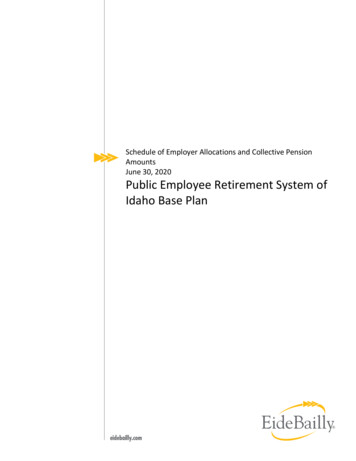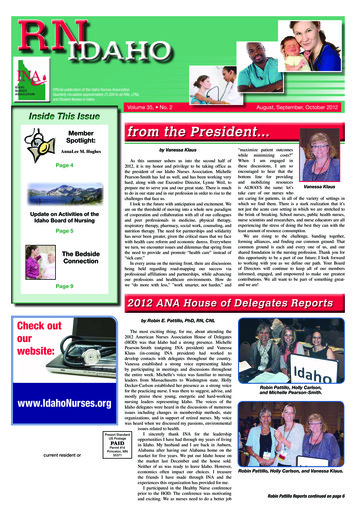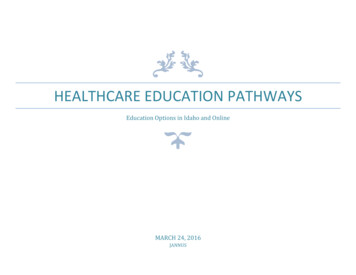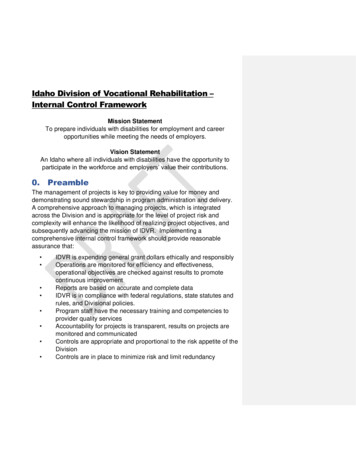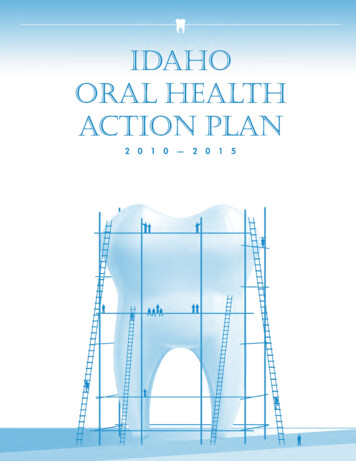
Transcription
I daho O ra l H e a l th A ction P l an 2 0 1 0 – 2 0 1 5ContentsIntroductionThe Impact of Oral HealthHow Big is the Challenge?Barriers to CarePartnerships for ChangeState Plan Goals3456710Goal 1: Prevention10Goal 2: Access to Care21Goal 3: Policy30Glossary36Selected References & Resources 38
I daho O ra l H e a l th A ction P l an 2 0 1 0 – 2 0 1 5“We Must Build AnEffective Health InfrastructureThat Meets The Oral Health NeedsOf All Americans And IntegratesOral Health Effectively IntoOverall Health. We Must WorkTo Change Perceptions AboutOral Health Among The General Public,Among Policymakers, AndAmong Health Providers.We Must Remove The BarriersBetween People And OralHealth Services.”David Satcher MD, PhDSurgeon General — 20001
I daho O ra l H e a l th A ction P l an 2 0 1 0 – 2 0 1 5I n t ro d u c t i o nPlan: A m e t h o d fo r m a k i n g, d o i n g o r a c c o m p l i s h i n g so m et hing.Action: Th e p ro c e ss of d o i n g.The Idaho Oral Health 5-Year State Plan is meant to be a plan of action, aroadmap to ensuring and improving the oral health of Idahoans. In November2007, the Idaho Oral Health Alliance (IOHA) convened the Idaho Oral HealthSummit to discuss the challenges and opportunities to improve oral health carein Idaho. That meeting was the first step in developing a course of action.National Call toAction to PromoteOral Health:“Advance the generalhealth and well-beingof all Americansby creating criticalpartnerships at alllevels of society toengage programs topromote oral healthand prevent disease.”US Department ofHealth and HumanServices 2003No one individual, agency, or organizationcan improve oral health care. Collaborationamong partners with common goals isessential to bring about the changesneeded in the oral health arena. The IOHArepresents this collaboration and definesitself as a non-profit organization of dentalprofessionals, public health agencies,businesses, community health providers,and individuals dedicated to better oralhealth and overall health for all Idahoans.The vision of the IOHA is to promotegood oral health and increase access topreventive and restorative care.Everyone can be involved in working onparts of this plan. Going forward we willneed to address the disparate burdenfaced by racial and ethnic minorities,children and the elderly, and people withlimited incomes and no dental insurance.We will need to be teachers and coacheshelping people learn how to care for theirown oral health. We will need to be oralhealth visionaries seeking funding to expandoral health care, developing policies thatimprove access to care, and linking oralhealth care to medical care.The Idaho Oral Health Alliance and partnersbelieve much of this 5-year plan is realisticand achievable. It will take commitment andpassion to accomplish the goals set forthin the plan. Judging by outreach programssuch as Give Kids a Smile organized bydentists and dental hygienists, oral healthcare given to participants in the Idahosponsored Special Olympics World WinterGames 2009, and school dental sealantprograms, the passion and drive is evident.3
I daho O ra l H e a l th A ction P l an 2 0 1 0 – 2 0 1 5The Impact Of Oral HealthIdaho oral health data indicate many Idahoans are at risk for poororal health outcomes. While there is slight improvement in manyareas of oral health care, there is growing concern that peopleare avoiding preventive oral health care because they are losingdental insurance and facing unemployment. Economic hardshipmay reverse the gradual progress being made.If a person earns lessthan 25,000, he or sheis 50% less likely to havean annual dental exam.2008 Idaho BehavioralRisk Factor SurveillanceSurveyGoal 1The Idaho Oral Health Plan Goals — InterconnectedThis Plan defines three interconnected goals — Prevention, Access to Care,and Policy. The goals and priorities do not stand alone, but are linked together.Preventive care occurs with access to care. Both are more likely to occurwith strong oral health policy in place. Accomplishing these goals and theiraccompanying priorities will take planning and collaboration. At the same timelinking the goals extends the opportunity to strengthen program interventionsand achieve the expected outcomes as outlined in the Plan.PreventionEmphasizes strategies to provide oral health education messages, preventivecare provided by oral health professionals, and community public healthprograms such as community water fluoridation and school-based fluoride andsealant programs.Goal 2 Access to CareIdentifies the most common barriers to oral health care in Idaho andrecommends solutions that will help to ensure effective care for pregnant women,children, adults, and seniors, as well as people who are at high risk for poororal health.Goal 3 PolicyRecognizes the importance of creating policies to ensure access to care andprevention, seeking funding and supporting oral health programs.4
I daho O ra l H e a l th A ction P l an 2 0 1 0 – 2 0 1 5How Big Is The Challenge?Oral health in Idaho is a serious public health issue.The incidence of oral disease is greater in children and adults who can leastafford care. Oral disease contributes significantly to the impact and cost ofoverall health care and can contribute to cardiovascular disease, stroke, preterm birth, poorly controlled diabetes and other systemic conditions.Idaho’s Medicaiddental programspends 38 millionannually (2009) —mostly for costlyrestorative care ortooth extractions.Dental caries or tooth decay is communicable through bacterial infection such asstreptococcus mutans which can be spread from parents to children. Young children andinfants are especially vulnerable to early childhood caries, a severe and rapidly developingform of tooth decay also called “baby bottle tooth decay.” Parents erroneously believe decayin primary teeth is not a concern because those teeth will be replaced by permanent teeth.They don’t realize the stage has been set for poor oral health during the child’s lifetime.Without regular preventive care, tooth decay can proceed without pain until damage issignificant, resulting in pain and costly repair is needed to restore tooth structure.5
I daho O ra l H e a l th A ction P l an 2 0 1 0 – 2 0 1 5Barriers To CareCultural and Income Disparities: People with lower incomes or of culturesless attuned to oral health self-care are at higher risk for poor oral health. At thesame time, they do not have the resources or the education to seek treatment orhelp until it is too late. People may feel they have no control over their oral health.Often there is a sense of hopelessness — “I will lose my teeth anyway, like the restof my family”, transference of blame — “I have soft teeth”, ignorance — “Brushingand flossing does no good”, and fear of cost — “Don’t go to the dentist — theywill charge you a fortune.”Access to Oral Health Providers: Most dentists graduate with a large debtfor their education averaging over 130,000. Loan forgiveness programs couldhelp new dentists establish practices and retiring dentists leave the workforce. Thenatural inclination is to establish a practice in a larger community where morepeople may afford dental care. Consequently, rural and low income areas mayhave fewer dental providers. As of 2008, 96.7% of the geographic area of Idahowas designated as a dental Health Professional Shortage Area (HPSA).Community Water Fluoridation: In 2006, Idaho ranked 45th among statesin the percentage of population (31.3%) served by a community water systemwith optimal fluoride levels. This alone contributes greatly to the high incidence ofcaries for Idahoans.Insufficient Safety-Net Care: Idaho has nine Federally Qualified CommunityDental Centers providing treatment at reduced fees depending on income. Accessto these centers is limited for those individuals who do not live near one of the ninecenters. Demand for care far exceeds the resources of these centers leaving manywithout low cost options. Hospitals report oral pain is the most frequent reasonpatients visit their emergency rooms where definitive care is not provided. Oralhealth emergencies drive up the cost of health care.SolutionsEducation: Aggressively educate the public on how to care for teeth and gumsand how to recognize early signs of disease.Loan Forgiveness: Apply for programs that support loan forgiveness for peoplegraduating from dental and dental hygiene school.Dental Home: Educate the public and dental and medical providers about theimportance of establishing a dental home, with emphasis on children by one yearof age.Community Water Fluoridation: Educate community leaders and policymakers about the value of water fluoridation and the health benefits that result.School-Based Dental Programs: Develop and promote school-basedprograms that provide fluoride varnish, fluoride mouthrinse and dental sealants tochildren.Medicaid: Enroll eligible children in Medicaid and increase Medicaidreimbursement for dentists.Community Health Centers: Increase the number of dental clinics linked toCHC primary health care.6
I daho O ra l H e a l th A ction P l an 2 0 1 0 – 2 0 1 5Partnerships For ChangeImproving oral health care in Idaho is an enormous undertaking. The human and financial demands alonefar exceed the capacity of any single group, community or public health entity, regardless of the level ofcommitment. Real success — something that is achievable and sustainable — can only be realized througha coordinated effort that brings together both traditional and non-traditional participants in a workingpartnership that is aligned with and guided by a central plan.PartnersIdaho Oral Health AllianceIdaho Dental Hygienists’ AssociationState PlanWorkgroupIdaho State Board of DentistryMuch thanks and appreciation are owed toIdaho Area Health Education Center (AHEC) Mountain States Groupthis group for their dedicated work towardIdaho Head Start Collaborationmaking the Idaho Oral Health Action PlanIdaho Oral Health Program2010 – 2015 a reality.Idaho Primary Care AssociationIdaho Public Health AssociationIdaho State University, Department of Dental SciencesPanhandle Health DistrictPublic Health Idaho — North Central DistrictSouthwest District Health DepartmentCentral District Health DepartmentSouth Central Public Health DistrictSoutheastern District Health DepartmentEastern Idaho Public Health DistrictAdvantage Dental PlanArthur R. SacksCarolyn Brammer, RDHDan L. Watt, DDSJanet Garlick, RDH, BSLinda Boyd, RDH, RD, EdDMimi Hartman-Cunningham, MA, RD, CDENaDene Palmer, MBAOmair Shamim MD, MHASally Kane, BSDH, RDH-EAVanessa Hanser, RDH-ER, BSDHAspen Dental Care – John McMurray, DDSBear Lake Dental Care, PLLC – Robert J. Timothy, DDS &Monty Westin, DDSCollege of Health Sciences – Boise State UniversityCenter for the Study of Aging – Boise State UniversityDentaQuestFriends of Children and Families Head StartMedicaidRegence Caring FoundationTerry Reilly Health ServicesAllyson Vansteenbergen MD, Meridian PediatricsAnita Herzog, BS, M.Ed, Professor Emeritus,Idaho State University Department of Dental HygieneJeffery Roth, DMDLarraine Evans Clayton, M.Ed,State Early Childhood Comprehensive Systems GrantMisty D. Robertson, RDHSally Kane, RDH-EASarah Toevs, RDH, PhDShari Williams, BS, RDS-ERVirginia Reyna-Walling RDH-EAIdaho Voices for Children7
I daho O ra l H e a l th A ction P l an 2 0 1 0 – 2 0 1 5A Few Idaho Oral HealthSpecial Smiles Idaho isindeed something specialitself. When 2,000 athletes from100 countries came to competein the Special Olympic 2009World Winter Games in Boise,Idaho, they were greeted by 262Special Smiles Idaho dentists,dental hygienists, assistants andstudents as well as 25 dentists andhygienists from 20 other statesand 15 dentists and hygienistsfrom 15 other countries. SpecialSmiles Idaho introduced the“Miles for Smiles” mobile dentalvan to the world and offered anydental treatment necessary forOlympic athletes. Since 2001,each year Idaho dentists haveopened their practices to providedental cleanings, X-rays, andany necessary work for SpecialOlympic athletes at no cost. TheSpecial Olympic Motto is: “Let mewin, but if I cannot win, let me bebrave in the attempt.” True enoughwords, especially if the contest isfor us to reach out to those lessfortunate.Special Smiles Idaho DirectorsJennifer Clayton RDHAmy Haugen RDH, MAOLDelta Dental of IdahoCommunity Outreach toIdaho SchoolsStudies show that children in lowincome families experience themost decay. To help change thisstatistic for Idaho children, DeltaDental’s Community Outreach stafftravels across Idaho to providefree dental sealant clinics on-sitein Idaho elementary and middleschools. Proven to help preventcavities, the dental sealant clinicsare conducted at schools where55% or more of the students qualifyfor free and reduced lunches. Sincebeginning the clinics in 2007,Delta Dental has seen over 8,000children, placing over 14,000sealants, and providing one-onone dental education in a positive,child-friendly environment. In 2011,Delta Dental is looking forward toseeing 7th graders, who were firstseen in their clinics as 3rd graders.It is hoped that these students willhave significantly lower cavity ratesthan other middle school students.Because of this outreach, childrenwho typically do not have a dentalhome are given access to long-termpreventive care and education.Delta Dental Community OutreachLisa Reed, Public Benefit ManagerTerry Reilly Boise andCanyon County Dental ClinicsWomen who are pregnant andpeople with diabetes may notrealize how important it is topractice good personal oral healthcare and see a dentist regularly.Through a special grant from theWomen’s Health Foundation,dentists at Terry Reilly DentalClinics provided free exams,risk assessments, personal careinstruction and a dental home-carekit to these Terry Reilly patients.Individual treatment plans for cariesand periodontal disease wereprovided to each patient. Why ispreventive dental care important forpregnant women and people withdiabetes? Mothers are consideredthe original source of bacteria fortheir child. Empowering mothersto understand the importance oftheir own oral health increases thechance they will have healthierchildren with a lower caries rateas they grow. People with diabetesare at higher risk for periodontaldisease if their diabetes is poorlymanaged. Most do not knoworal disease is a complication ofdiabetes. Of the people seen in theTerry Reilly program, 30% showeda marked improvement in their oralhealth and were enthusiastic abouttheir progress. Preventive careworks.Terry Reilly Dental DirectorDan Watt, DDS8
I daho O ra l H e a l th A ction P l an 2 0 1 0 – 2 0 1 5Successes To Smile About.Idaho Dental Hygienists’Association (IDHA)Hygienists Go To SchoolWilder, Idaho is a small ruraltown with low-income familiesand kids in need of preventiveoral health care. With enthusiasticsupport from the Wilder SchoolDistrict, IDHA volunteer hygienists,the Regence Caring Foundation,and volunteer dentist, Dr. AllanStevenson, provided free dentalscreenings and oral hygieneeducation to 343 children inkindergarten through 12th grade.About 10% of the students hadurgent dental needs and werereferred for treatment. The schoolnurse followed up to make suretreatment was obtained. Of thechildren seen, only 15% hadpreventive dental sealants. Fiftypercent of the children, who didnot have dental problems, haddental sealants.Idaho Dental Hygienists’AssociationSusan Cameron, RDH-EA, BS,Executive DirectorHealthy Smiles HappyChildren—Reaching LatinoChildrenSome of the highest risk kids inIdaho for poor oral health maybe those in Latino communities insouthwest Idaho. These childrenare less likely to see a dentistand are more likely to experiencedental caries than other children.Southwest District Health’s (SWDH)Oral Health Program workswith SWDH’s Women Infantsand Children (WIC) clinics, theRegence Caring Foundationand Burkhart Dental to providechildren and their parents withbi-lingual care, Spanish languageeducational materials, fluoridevarnish, and self-care essentialssuch as toothbrushes, dentalfloss and brushing timers. Mostimportantly these children arereferred to a “dental home” wherethey are more likely to receiveregular preventive dental care.Since the program began in 2006,the number of children receivingcare has doubled. In 2009, 945children were served. Of those,over 400 were Latino children,two to three years old, who nowhave a better chance of good oralhealth.Give Kids a SmilePartnerships get things done. Since2003, every February the EasternIdaho Public Health District OralHealth Program coordinates GiveKids a Smile Day, the AmericanDental Association’s signaturenational dental access event.The event has grown. In 2009the Upper Snake River DentalSociety, the media, schools,parents, 50 volunteer dentistsand 200 volunteer auxiliaries,donated approximately 116,000worth of dental services to 495low income, high-risk childrenages 2 to 18 years old whodo not normally have access todental care. Preventive servicesincluded exams, X-rays, cleaning,fluoride varnish and sealants.Restorative care included fillings,pulpotomies, and extractions.Delta Dental provided oral hygienekits to the children. Over the sixyears, the dental community hasprovided 546,000 in services.Partnerships matter.Eastern Idaho Public Health DistrictElyse Baird, RDH, Oral Health ProgramCoordinatorSouthwest District HealthVirginia Reyna-Walling, RDH, OralHealth Program Coordinator9
I daho O ra l H e a l th A ction P l an 2 0 1 0 – 2 0 1 5Goal 1 PreventionOptimal oral health across the life span, in families, and throughoutIdaho communities begins with prevention practices including personaloral health care practices and access to regular preventive dental care.To meet oral healthneeds we must thinkbeyond the status quoand assure that decisionsare based on evidenceand not simply tradition.Sarah Toevs, RHD, PhD,Boise State UniversityPrevention also begins with mothers having a healthy pregnancy, parents caring for“baby” teeth and teaching their children the importance of brushing and flossingand modeling proper self-care. Prevention involves communities deciding to fluoridatetheir water supplies and school systems supporting fluoride programs, oral selfcare education and dental sealant programs. In senior centers and long-term caresettings preventive care must be emphasized for the comfort and health of residents.Prevention also means working at the policy level to ensure access to oral healthcare is available and affordable to everyone. Evidence supports that the cost of oralhealth care is reduced when preventive care is emphasized. Optimally all people,regardless of age, income, race or ethnicity should have an accessible dental home.Good health is linked to good oral health.Approximately 60%of Idaho third gradershad dental sealantson one or more teeth.22.5% of Idaho thirdgraders had untreatedtooth decay.2009 Idaho SmileSurvey10
I daho O ra l H e a l th A ction P l an 2 0 1 0 – 2 0 1 5Priority 1Population-Based Preventive Dental MeasuresTo achieve optimal oral health for Idaho citizens across all ages, programsand policies need to be identified and recommended by oral health experts. Oral health experts must take the lead in establishing and implementing programsto benefit the public. For example, the science and evidence shows communities withadequate water fluoridation have a lower rate of tooth decay.1 Children and adults who have a dental home and a life-long practice of personal oralhealth care can expect better oral health and general health.a Children with a dental home by age one have significantly fewer restorative dental needsthroughout their lifespan.2, 3 Children with dental sealants are less likely to experience tooth decay.4 Using the school setting to teach good oral health habits and implement preventiveprograms, such as fluoride mouthrinse, fluoride varnish and dental sealant programs,ensures better oral health outcomes for kids.“Community waterInterventionsfluoridation remains one1.1 — Community Water Fluoridation: Promote optimal fluoridation in community watersystems in Idaho. As of 2010, 31% of Idaho community water systems provide fluoridation.of the great achievementsof public health in thetwentieth century — aninexpensive means of Inform and educate the public and policy makers about the importance of waterfluoridation by linking tooth decay incidence to fluoridation status.5improving oral health that Create local fluoride policy examples for communities to adopt.benefits all residents ofExpected Outcomesa community, young andold, rich and poor alike.”David Satcher MD, PhDSurgeon General Increased number of communities with an optimally fluoridated water supply. Reduced amount of tooth decay in children and adults living in communities withfluoridated tedOctober2005.Dental Home: The ongoing relationship between the dentist who is the Primary Dental Care Provider and the patients,which includes comprehensive oral health care, beginning no later than age one, pursuant to ADA policy.11
I daho O ra l H e a l th A ction P l an 2 0 1 0 – 2 0 1 5Priority 1Interventions1.2 — School-based Oral Health Programs: Provide dental programs and educationthat promote healthy teeth and gums in the school setting. Good oral health supportsacademic achievement.6School-based Tooth Decay Prevention Programs: Encourage partnerships betweenschools, local public health districts, and dental organizations to provide school-baseddental programs such as sealant clinics, fluoride mouth rinse and fluoride varnishprograms.The prevalence of four ormore teeth with untreateddecay for students inlow-income schools wassignificantly higher (27.4%)than among high-incomeschools (14.4%).2009 Idaho Smile SurveySchool-based Oral Health Education: Encourage and work with schools and schoolnurses to implement oral health programs that educate teachers, staff, parents andchildren about life-long oral health habits such as proper brushing and flossing,healthy eating, and regular dental checkups.Basic Smile Survey: In collaboration with the Idaho Oral Health Program and IdahoState Department of Education, engage schools to conduct the Smile Survey every fouryears to measure and report on the oral health status of elementary school children.7Expected Outcomes Increased number of schools with fluoride mouthrinse, fluoride varnish and sealantprograms and oral health education provided to students. Increased number of school children with sealants on first and permanent molars. Decreased number of children with decay in primary and permanent teeth. Assurance the Basic Smile Survey, as an ongoing assessment of Idaho children’s oralhealth status, is scheduled at a minimum of every four years.Interventions1.3 — Day Care and Pre-School Programs: Children may eat one to two meals aday during the week in pre-school or day care settings. The staff in these settings canestablish oral health procedures for the children in their care with training and supportfrom oral health professionals.Day Care and Pre-School Settings: Implement programs that train staff in pre-schooland day-care settings about oral health including tooth brushing, teaching childrenand parents about self-care and healthy eating. Programs should include modelinggood oral health care by staff.Expected Outcomes Increased number of pre-schools and day care programs with oral health programsthat include trained staff and oral health care for children.12
I daho O ra l H e a l th A ction P l an 2 0 1 0 – 2 0 1 5InterventionsPriority 11.4 — American Academy of Pediatric Dentistry (AAPD) Guidelines: The AAPD ClinicalGuidelines provide recognized practice recommendations concerning direct patientcare for children.8AAPD Guidelines: Adopt and promote AAPD Guidelines for infant oral hygiene,counseling on harmful oral habits, preventing dental injuries, and promoting initial oralexams within six to twelve months of age or with the emergence of the first primarytooth.AAPD Dental Home: Support adoption and promotion of the AAPD recommendationthat children have a dental home by age one.bExpected OutcomesLess than half of Idahomothers (46.9%) who gavebirth had a dental visitduring their pregnancy.Only 47.9% reported Increased awareness and adoption of AAPD Guidelines in oral health educationprograms targeting parents, families and pediatricians. Increased number of children who have a dental home by age one.being counseled aboutInterventionsthe importance of dental1.5 — Oral Health Care for Mothers, Infants and Children: Proper dental care duringthe perinatal period may help prevent pre-term and low birth weight babies and is animportant aspect of overall health for pregnant women.9 Research shows mothers oftentransmit oral pathogens to their infants setting the stage for oral disease in their child.Delivery of oral health care is not only safe during pregnancy, but also increases thelikelihood children will begin life with good oral health. According to the AmericanAcademy of Pediatrics (AAP), every child should begin to receive oral health riskassessments by 6 months of age by a qualified pediatrician or a qualified pediatrichealth care professional.10care during pregnancy.2007 Idaho Pregnancy RiskAssessment Tracking System(PRATS)Oral Health Care During Pregnancy: Partner with oral health professionals, physicians,allied health professionals, public health and community organizations to develop astrategy to ensure women in Idaho seek and have access to preventive dental careduring pregnancy.Education of Pregnant Women: Develop health messages and opportunities thatpromote and support pregnant women to seek dental care during pregnancy. Educatewomen about risk of transmission of dental disease to their children.Education of Obstetricians and Primary Care Physicians: Educate physicians to educatepregnant patients about the importance of oral care and fluoride use.Primary Medical Care: Educate and use family practice and pediatric medical settingsfor oral health risk assessments, for the use of topical fluoride at well-child visits and forensuring children are referred to a dental home by age one.Women Infants and Children (WIC) Program: Ensure local district health departments’oral health programs collaborate with WIC to provide oral health education toparents/caregivers starting during pregnancy and continuing after childbirth. Thisincludes offering fluoride varnish to children enrolled in nt, inclusive of all aspects of oral health care delivered in a comprehensive, continuously accessible,coordinated and family-centered way.”13
I daho O ra l H e a l th A ction P l an 2 0 1 0 – 2 0 1 5Priority 1First Teeth: Develop health messages encouraging appropriate topical and systemicfluoride as soon as teeth erupt. Messages should include age appropriate home carehabits involving caregivers.Head Start: Support Head Start to offer oral health services and education throughHead Start settings that include: Providing oral healthcare training and education to Head Start staff and familyadvocates. Offering topical fluoride to Head Start children following evidence-based guidelines. Promoting the use of the Head Start dental program as the model for other pre-schoolprograms.Expected Outcomes Increased collaboration among oral health and medical professionals and communityorganizations to ensure pregnant women have access to preventive oral health care. Increased number of pregnant women who seek and receive oral health care duringpregnancy. Increased knowledge and awareness of parents and caregivers about the importanceof good oral health, proper oral health care habits, and transmissibility of dentaldisease between family members. Increased utilization of topical fluoride in multiple settings, such as physician officesand Head Start and other pre-school centers. Increased number of children who have a dental home by age one.Interventions1.6 — Oral and Dental Aspects of Child Abuse and Neglect: Oral health professionalsshould be aware of and recognize cases of potential abuse and neglect in children.Guidance is provided by the American Academy of Pediatrics (AAP) and the AmericanAcademy of Pediatric Dentistry (AAPD).11P.A.N.D.A — Prevent Abuse and Neglect through Dental Awareness 12Through collaborative effort with oral health professionals, evaluate the opportunity todevelop and implement a PANDA program in Idaho.Expected Outcomes Increased awareness among oral health professionals and communities about abuseand neglect in children as well as adults.14
I daho O ra l H e a l th A ction P l an 2 0 1 0 – 2 0 1 5Priority 271.4% of adults havenever had permanent toothextracted because of dentalcaries or periodontal disease.This surpasses the HealthyOral Health EducationMost people are unaware of how important oral health care is to their overallgood health. For many reasons people do not seek regular dental checkupsand lack consistent routine preventive care.People of other cultures and speaking other languages may not have information about oralhealth care and may not seek care. Most oral health diseases are preventable which may notbe known to the public. Dental and medical professionals play an important role in educatingpeople about healthy behaviors such as good nutrition, tobacco cessation as well as personaloral health care. Education should include cultural and language specific information.Often neglected and not understood is the link between good oral health and successfulmanagement of chronic diseases such as diabetes and cardiovascular disease. Therefore oralhealth education must include helping people understand their risks.Interventions2.1 — Educating the Publi
IA H O D O R A l H e A lT H A C T I O N P l A N 2 0 1 0 - 2 0 1 5 1 "we must BuIld an effectIve health Infrastructure that meets the oral health needs of all amerIcans and Integrates oral health effectIvely Into overall health. we must work to change perceptIons aBout oral health among the general puBlIc, among polIcymakers, and among health provIders. we must remove the BarrIers Between .
